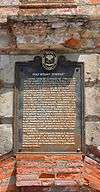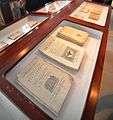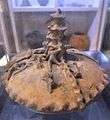Holy Rosary Minor Seminary
Holy Rosary Minor Seminary (also named Seminario del Santissimo Rosario) is a Roman Catholic seminary or a house of formation for high school and college would-be priests run by the Archdiocese of Caceres in Naga City, Philippines.

History
Founded on March 7, 1793 by Archbishop Antonio Gallego of Manila, Holy Rosary Minor Seminary started as Casa de Clerigos (House of Clerics) in a place called Padian (now, Caceres St.) near the Bicol River.[1] It was canonically erected as Seminario Conciliar de Nueva Caceres in compliance with the Tridentine Decree that every diocese must have a seminary. In 1840, it was transferred from Padian to its present site along Elias Angeles St. When the seminary building opened in 1793 it was made of wood, bamboo and nipa which a certain bishop noted as "combustible and of non-durable materials".[1] The initial staff was composed of a rector (provisor and vicar general of the diocese); a vice-rector(a Franciscan professor) and two other professors who taught Latin and Humanities. In nine years after its opening, it had 11 deacons, 24 subdeacon and 247 minor seminarians. In 1855, the seminary building was damaged by a strong earthquake and a fire razed it the ground in 1863.[1] In 1865, Nueva Caceres Bishop Francisco Gainza, O.P. rebuilt and expanded the new seminary building. The Vincentian Fathers (C.M.) took over the management and formation of the seminary in 1865 to become a seminary-college and center of education for lay people in Southern Luzon. In 1925, Bishop Francisco Reyes renamed it as Seminario del Santissimo Rosario and abolished the College and retained the Conciliar Seminary. It was partly damaged when it was bombed by the Japanese during the second war. In 1964, It was renamed Holy Rosary Minor Seminary under the new management of Diocese of Clegy. In 1970, A powerful typhoon extensively damaged the Seminary and was rebuilt under the leadership of Archbishop Teopisto Alberto.

It was declared as a National Historical Landmark on June 11, 1978 by then National Historical Institute as a tribute to its having produced martyrs, patriots and heroes like Jose Maria Panganiban, Tomas Arejola and nine of the fifteen Bikol Martyrs namely, Gabriel Prieto, P. Severino Diaz, Leon Hernandez, Mariano Ordinanza, Mariano Arana, Camilo Jacob, Ramon Abella, Domingo Abella and Tomas Prieto.[2] Among its prominent alumni are Bishop Jorgr Barlin, the first Filipino Bishop, Jose Tomas Cardinal Sanchez and 21 other bishops in the country.
Architecture and fittings

The two-storey brick structure is rectangular in plan with eclectic Italian Renaissance ornamentation. Its composition is symmetrical with a central block and indented right and left wings.Its ground floor facade is a series of brick arches quite similar to Florentine Renaissance architecture.On the roof level is a brick cornice above the frieze composed of triglyphs and regula,elements from classical Greek Architecture.The frieze is supported by a stylized Doric crenelated brick pilaster.The first storey has floors and walls paved with plain and brightly colored tiles, while its arcaded corridors often glimpse of its quiet garden soothing areas for peace & contemplation winding up to the upper floor its balustrade staircase paved in black and white checker board pattern.Its second storey was built of Philippine hardwood as seen in its flowing beams and trusses. Its roof of galvanized iron sheet was once a bright cap of red tiles was the style of the period. At the first floor are the visitors’ area, offices, classrooms, refectory, main kitchen, the recreation hall and the auditorium. At the upper floor are the chapel, study hall, dormitory and the rooms of the priest, the spiritual room& the library[3] The second floor facade are verandahs supported by a projection of brick cornices with ornamental ironwork fern design ledge. The doors are topped by corniced rain-stopper.


Museum
In September 5, 1988 the late Archbishop Leonardo Legaspi renamed it back to Holy Rosary Minor Seminary and inaugurated the Museo del Seminario Conciliar de Nueva Caceres which houses altars and statues, books and vestments used by bishops and priests.
Library
In October 17, 2003, the late Archbishop Legaspi opened the Bishop Domingo Collantes Library with a 30,000-book collection and can sit 100 readers in its 280 sq. m. hall.
Education
The seminary now offers K-12 Curriculum. With courses of the General Academic Strand (GAS), Philosophy, Journalism and others.
Administration
Presently the Seminary is under the leadership of Most Reverend Rolando Tria Tirona O.C.D. D.D. of the Archdiocese of Caceres. Its rector is Fr. Mario Arnulfo B. Gaite with the assistance of, namely: Fr. Jay Jose L. Jacinto (Director of Human and Intellectual Formation and Vice-Rector), Fr. Enrico Julian Paglinawan (Vice - Principal),, Fr. Jay S. Aguilar (Director of Spiritual), Fr. Jowi B. Resayaga (Prefect of Discipline and Director in Liturgy) and Fr. Rolando Canonce (Director of Pastoral Formation); together with former DepEd (Region 5 - Bicol) Regional Director Dr. Orfelina O. Tuy as its present principal with the teaching and non - teaching faculty and staff.
Gallery
 Arcaded Facade
Arcaded Facade Seminary Lobby
Seminary Lobby Inside Courtyard
Inside Courtyard Ecclesiastical Museum Altars and Seats
Ecclesiastical Museum Altars and Seats Ecclesiastical Museum Old Books
Ecclesiastical Museum Old Books Archeological Museum Entrance
Archeological Museum Entrance Burail Jars
Burail Jars Burial Jar Cover
Burial Jar Cover
References
- 1 2 3 Gerona, Danilo (1988). From Epic to History A Brief Introduction to Bicol History. Naga City: Ateneo de Naga. p. 81.
- ↑ "Resolution No. 1, s. 1988. Declaring the Holy Rosary Minor Seminary in Naga City, Camarines Sur as a National Landmark." (PDF). National Historical Commission of the Philippines. Retrieved 15 October 2014.
- ↑ .http://humanitiesgroup1.blogspot.com/2009/12/holy-rosary-minor-seminary-naga-city.html
External links
 Media related to Holy Rosary Minor Seminary, Naga at Wikimedia Commons
Media related to Holy Rosary Minor Seminary, Naga at Wikimedia Commons- Official website
Coordinates: 13°37′40″N 123°11′11″E / 13.6279°N 123.1864°E